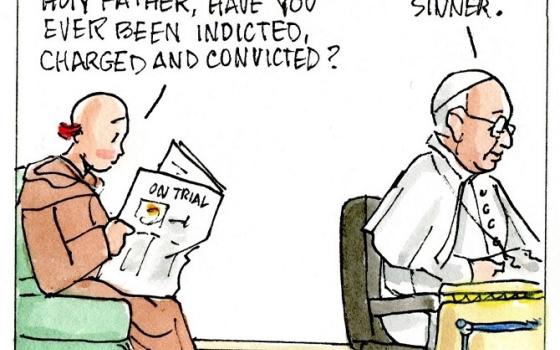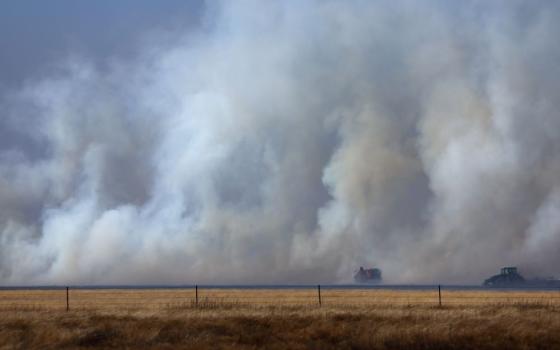Over at First Things, Joe Carter and The Anchoress raise the question of which hymns sung in churches today are the worst. It is a fine question and one that matters deeply to regular church goers, although I think there is something unnecessarily censorious, and just so un-Roman, about only listing the worst without listing the best too. The best of hymns are like little symphonies, so much joy in such a small package.
I do not quibble with the First Things list, which includes such dreadful works as “Gather Us In,” which my pastor has banned, and “City of God,” the lyrics of which stray far from their Augustinian title. But I take exception to one item on the list. The hymn “I am the Bread of Life” does not fit the writers’ objections to the other hymns on the list. Its words are not saccharin-like as are the others: They are drawn from one of the most powerful passages in the entire Scripture, the Sixth Chapter of the Gospel of John. Nor is the tune the kind of sing-songy, major key melody that grates one’s nerves in the morning hours. And, it is singable. I recall the first time I heard it. I was at Mass at the Cathedral of St. Mary in San Francisco. My best friend was dying, indeed, I had not wanted to leave Washington on my business trip because his death was imminent but he insisted. We sang “I am the Bread of Life” at communion and by the time we got to the explicit statement of faith in the fifth and final verse – “Yes, Lord, I believe, that you are the Christ” – the tears were streaming down my cheek. When it came time to select the music for my mother’s funeral that was the first hymn I chose and the soprano sang a descant that is still in my ears. I hereby give notice that anyone who attends my funeral will be asked to sing it as well. Tell the organist to pull out all the stops and to do a riff on the chorus in the final verses.
There is an undertone in the Anchoress’ article that seems to suggest that bad hymns are unique to the modern age. This is quite wrong. Apart from those bad hymns which did not survive – history is a great cleanser of bad art – I have in my hands the “Pius X Hymnal” published in 1953, with an imprimatur from then-Archbishop Richard J. Cushing, Archbishop of Boston, although I suspect the imprimatur extends only to the theology of the hymns, not their musicality. The hymnal is filled with Victorian schmaltz that is every bit as embarrassing as anything written in the 1970s.
So, what are the best hymns? We all have favorites that are seasonal, but let’s leave those aside and concentrate on those that can be sung at any Mass. Most of my selections come from Worship III.
10. “Veni Creator Spiritus” – If you are only going to learn one Latin hymn, this is the one. Hauntingly beautiful melody and when is it not appropriate to call on the Spirit?
9. “Come Down O Love Divine” – If you need to invoke the Spirit in English, this is your hymn. Beautiful words: “Seek now this soul of mine, And visit it with thine own ardor glowing” and “O, Let it freely burn, Till earthly passions turn to dust and ashes in its heat consuming.” And a tune that stays with you forever. When you hit the C natural at the beginning of the 13th measure, you know you are in the 20th century and that Vaughn Williams is capable of writing music on a par with any of his great predecessors.
8. “Rejoice the Lord is King” – The tune, “Darwall’s 148th” has many different words, and my favorite are found in the 1940 Episcopal hymnal, “Ye Holy Angels Bright.” With whatever words, however, the bass line is easy to sing and the words “The keys of death and hell are to our Jesus giv’n” work for me.
7. “Holy God We Praise Thy Name” – This is the English Te Deum. It was never one of my favorites until I went to a service for a meeting of organists and choir directors and heard 600 people belt it out.
6. “Sing Praise to God Who Reigns Above” – this is, like Duke Street, one of those tunes with great movement and force. And the final verse includes these words which seem so necessary in American culture, perhaps every culture: “Cast each false idol, from its throne, Te Lord is God and He alone.”
5. “Glorious Things of Thee Are Spoken” – Not in Worship III but easily found elsewhere. The words from the psalmist are enormously focused on the hope of the Resurrection. There are several tunes for the words, and the most common is the tune “Austria” by Haydn which unfortunately is also the tune for the German national anthem “Deutschland, Deutschland, uber alles.” I recommend singing it to the tune “Abbot’s Leigh” which is most commonly known to an American audience as the tune for “Lord, You Give the Great Commission.”
4. “Guide Me Thou, O Great Jehovah.” Another hymn not found in Worship and, strangely, not found in the 1940 Episcopal Hymnal, but it made it into the 1982 Hymnal. The tune, “Cwm Rhonddha, is one of those great, old Welsh drinking songs. So, what was once “Live for beer, live for beer, drink and drink until you drop” is now “Bread of Heaven, Bread of Heaven, Feed me now and evermore.” It also contains another great summation of the Christian faith in the Resurrection: “Death of death and Hell’s Destruction.” And the bass line at the end of the chorus is a killer.
3. “I am the Bread of Life” – see above.
2. “At That First Eucharist” – very simple melody, so no excuse not to sing it, even with the worst of choirs. Unfortunately, Worship III does not include the beautiful fourth verse which points, like the Eucharist itself, to the heavenly banquet:
“So, Lord, at length when sacraments shall cease, May we be one with all Thy Church above, One with Thy saints in one unbroken peace, One with Thy saints in one unbounded love; More blessèd still, in peace and love to be, One with the Trinity in Unity.”
1.“The Church of Christ in Every Age” – There is nothing sing-songy about this 20th century contribution to the hymnal. The tune is minor and discordant, but transcendant, like some of Mahler’s best leider. The second verse has extraordinary words: “Across the world, across the street, The victims of injustice cry; For shelter and for beard to eat, And never live until they die.” And, like many of my selections, it is explicit in affirming the dogmas of the Church. Hymnody is a great catechetical tool.
Now, so far from being censorious, I can tell you that if you ask me tomorrow, I shall have a significantly different list of favorites. La dolce vita! Faith - and the music that raises our prayers to the Heavens - these , too, come in many flavors. I invite the readers to submit their lists!




